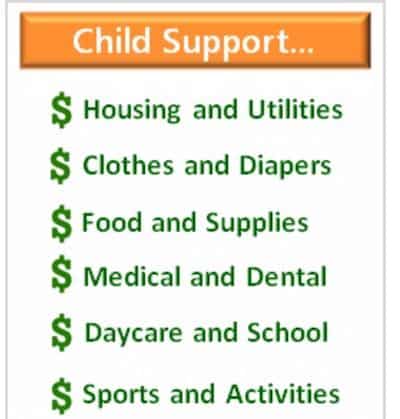What is Child Support For

Many parents ask, especially the parent required to pay for child support, what is child support for? When parents separate, child support is the monetary obligation paid by the non-custodial parent to the custodial parent to provide for the needs of their biological child. In New York, child support can run until the child turns 21. The custodial parent is the parent with physical custody who lives with the child most of the time, while the other is the non-custodial parent.
Parents don’t have to be married to have the obligation to pay child support. It is enough that the child is their biological child. The process to pay child support, however, is different if the parents aren’t married. In New York, when parents are married and a child is born during the marriage, the child is presumed to be the biological child of the married parents. On the other hand, if the parents are not married and a child is born, a paternity test is required to prove that the father is the biological parent of the child, and only after proof of such parentage is the father required to pay child support.
In some instances, a stepparent may be required to pay child support if the support from the biological parents is insufficient to keep the child off public assistance. Matter of Monroe County Dept of Soc Servs. v. Palermo, 192 A.D.2d 1114 (1993). See also Family Ct Act §§ 413, 415; Matter of Slochowsky v Shang, 67 A.D.2d 926, 928, affd 48 N.Y.2d 887; Matter of Buscaglia v Tutko, 86 A.D.2d 974.
Once a parent is required to pay child support, the parent often wonders, ‘what is child support used for?’ In New York, child support is not limited to food, housing, and clothing, but may also include healthcare, education, childcare, and extracurricular activities. Healthcare refers to the children’s medical insurance premiums and other reasonable healthcare costs not covered by health insurance, such as copays, dental braces, and eyeglasses. Aside from school supplies, education may refer to private school tuition and tutoring services. Childcare services needed when the custodial parent has to go to work can also be factored into child support payment. Sometimes, costs of extracurricular activities, such as participation in sports teams, is also included in child support.
Proving and Computing Child Support
Aside from wondering what child support for is, it is also important to determine how to compute for child support. When a custodial parent files a petition for child support or requests for child support in a divorce case, a hearing is held where both parents are required to show the court their latest income tax returns. The gross income in the income tax return shall be the basis for the court in computing for the combined income of the parents. The custodial parent is also required to show receipts for the living expenses used for the child. Although this will aid the court in determining the child’s living expenses, the court generally uses the child support guidelines provided under the New York Family Court Act §§ 413 and 413-a.
Under the guidelines, the court determines the income of the parent based on their income tax returns. The income includes wages, social security benefits, veteran’s benefits, and unemployment insurance benefits, but excludes supplemental security income. The court will subtract child support for other children and taxes from the income, and then add both parents’ income to arrive at the combined income.
From the combined income, the court multiplies it by a percentage depending on the number of children shared: 17% for one child; 25% for two children; 29% for three children; 31% for four children; and 35% for five or more children. Thereafter, the court divides the amount based on the proportion of the individual income of the parent over the combined parental income.
For example, John and Martha are married and have two children. Thereafter, they decide to divorce with the children living with Martha. John’s income after deductions for purposes of child support is $50,000 yearly, while Martha’s is $30,000. John and Martha’s combined parental income is $80,000. Since they have two children, child support is 25% of the combined parental income of $80,000, which is $20,000 annually. Since John’s proportion of the combined parental income is 62.5% (50,000/80,000), his share of the child support is 12,500 annually. Martha’s share is 37.5% (30,000/80,000), equivalent to 7,500 annually. Thus, John is required to pay $1,041.67 monthly of child support to Martha.
The child support paid by the non-custodial parent may be increased or decreased by the court depending on certain factors, such as the cost of living in the area where the child lives in, whether the child has special needs, and other considerations. If the combined parental income is $154,000, the court has two options: to use the same formula for all of the combined income or to use the formula only for the first $154,000 and to decide how much of the remainder should be used for child support given the financial resources of the parents, the child’s physical and emotional needs, the tax consequences of the child support, and the child’s standard of living if there had been no divorce.
Child Support by Agreement
Despite knowing the amount of child support based on state guidelines and what child support will be for, the parents may still decide on a different child support amount based on agreement. The agreement, however, must state that the parents have been advised of Domestic Relations Law § 240 (1-b) and Family Court Act § 413(1)(b) and that the basic child support obligation results to the correct amount of child support. This agreement also has to be accepted by the judge based on considerations of the best interests of the child and incorporated into the divorce decree or support order.
Implementation of Child Support
In New York, the non-custodial parent can pay the child support to the custodial parent directly or through the Child Support Collection Unit. This unit can automatically enforce child support payments through payroll deductions, by taking state and federal income tax refunds, seizing assets, suspending driver’s licenses, and notifying credit reporting agencies of overdue child support payments.
Modification of Child Support Amount
The amount of child support may be modified if there has been a substantial change in circumstances, three years have elapsed since the order was entered or last modified, or there was an involuntary change in either party’s gross income up or down by 15% or more since the order was entered. However, if the non-custodial parent voluntarily terminates his own employment or accepts underemployment in order to request for a lower child support amount, the court can still impute income to that non-custodial parent. For example, John, who was previously earning $50,000 yearly voluntarily and intentionally resigned from his job to get another job paying $30,000 annually, the court can impute the $20,000 deficit to John if the court believes that John is capable of earning more for purposes of child support.
Child support has several factors to be considered. Although parents can agree on an amount for child support payment, it is best to get the services of lawyer when negotiating this amount. When administrative enforcement processes, such as income execution, unemployment insurance intercept, income tax refund offset, driver’s license suspension, etc.) are not successful, you can file an enforcement or violation petition, requesting the court to enforce the order and collect past due payments.
If you are wondering what child support is for or you are in need of child support representation, we, at the law offices of Albert Goodwin, are here for you. We have offices in New York City, Brooklyn, NY and Queens, NY. You can call us at 212-233-1233 or send us an email at [email protected].
